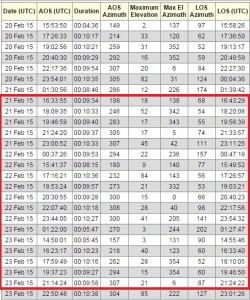From ARISS:
http://www.ariss.org/news.html
February 11, 2015
Another Round of SSTV Activity from the ISS is scheduled for Late February
Space enthusiasts have another chance to receive SSTV image transmissions activity from the International Space Station. Participants can anticipate watching for the transmissions from February 21, 2015 through February 23, 2015.
The pictures to be downlinked will be a repeat of the Series 1 images commemorating Russian space history that were previously sent during the weekend of December 18, 2014 until December 20, 2014.
SSTV transmissions will begin running non-stop on February 21 and ending at 21:30 UTC on February 23. As in previous sessions, the mode used to transmit the Slow Scan TV signals will be PD180 producing a high quality images with a frame scan of 187 seconds. A total of 12 different photos will be sent throughout an operation period. The transmit frequency will be 145.800 MHz with a 3-minute off time between transmissions. Received images can be uploaded to the image gallery found at http://www.spaceflightsoftware.com/ARISS_SSTV/index.php .
Plans are being discussed for transmitting new images from space enthusiasts around the world in upcoming months. Watch for more details that will be released about the upcoming SSTV transmissions to begin February 21.
Just a couple days after… NASA announced Upcoming EVA (Space Walk) was delayed to the same weekend as the planned transmissions. Amateur radio equipment needs to be shut off during the EVA. Rumors are floating around about delaying the SSTV transmissions until the 22nd-24th.
Stay tuned to the following website to see if it’s still going to happen
http://www.ariss.org/news.html
If everything goes as planned, there are many chances to catch the ISS here in Hampden county. Below is an image of the upcoming ISS passes. The passes in the red box were originally going to be transmitting SSTV. Still not sure if it’s going to happen.
 If there is indeed a transmission, there are some really good overhead passes. All that is needed for the pass is receiver that can receive VHF, Audio cable, Laptop with SSTV software that can decode PD180 Mode (MMSSTV) and either a handheld directional antenna (Tape measure yagi for example)
If there is indeed a transmission, there are some really good overhead passes. All that is needed for the pass is receiver that can receive VHF, Audio cable, Laptop with SSTV software that can decode PD180 Mode (MMSSTV) and either a handheld directional antenna (Tape measure yagi for example)
Stay Tuned…
NT1K